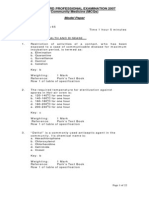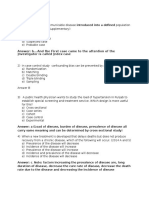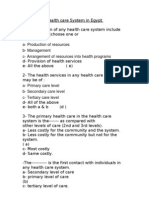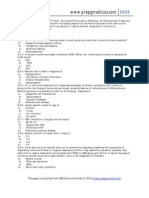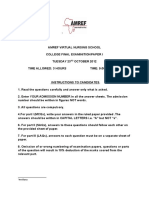100%(3)100% found this document useful (3 votes)
2K viewsCommunity Medicine MCQ
Community Medicine MCQ
Uploaded by
rajuchaThis document contains 10 multiple choice questions related to community medicine. The questions cover topics such as communicable diseases, occupational health hazards, immunization schedules, water contamination, light exposure risks, epidemiological investigations, and risk factors for cervical cancer. Correct answers are provided for self-assessment.
Copyright:
© All Rights Reserved
Available Formats
Download as PDF, TXT or read online from Scribd
Community Medicine MCQ
Community Medicine MCQ
Uploaded by
rajucha100%(3)100% found this document useful (3 votes)
2K views2 pagesThis document contains 10 multiple choice questions related to community medicine. The questions cover topics such as communicable diseases, occupational health hazards, immunization schedules, water contamination, light exposure risks, epidemiological investigations, and risk factors for cervical cancer. Correct answers are provided for self-assessment.
Original Description:
MCQs for community medicine students
Original Title
Community Medicine Mcq
Copyright
© © All Rights Reserved
Available Formats
PDF, TXT or read online from Scribd
Share this document
Did you find this document useful?
Is this content inappropriate?
This document contains 10 multiple choice questions related to community medicine. The questions cover topics such as communicable diseases, occupational health hazards, immunization schedules, water contamination, light exposure risks, epidemiological investigations, and risk factors for cervical cancer. Correct answers are provided for self-assessment.
Copyright:
© All Rights Reserved
Available Formats
Download as PDF, TXT or read online from Scribd
Download as pdf or txt
100%(3)100% found this document useful (3 votes)
2K views2 pagesCommunity Medicine MCQ
Community Medicine MCQ
Uploaded by
rajuchaThis document contains 10 multiple choice questions related to community medicine. The questions cover topics such as communicable diseases, occupational health hazards, immunization schedules, water contamination, light exposure risks, epidemiological investigations, and risk factors for cervical cancer. Correct answers are provided for self-assessment.
Copyright:
© All Rights Reserved
Available Formats
Download as PDF, TXT or read online from Scribd
Download as pdf or txt
You are on page 1of 2
MBBS THIRD PROFESSIONAL
MODEL QUESTIONS FOR ANNUAL 2009
Community Medicine
(Multiple Choice Questions)
Q.1 There was a tableau held at a hospital on the world childrens day to
demonstrate the importance of ORS in dehydration with a back drop of
ORS, breast feeding and MCH service. This method is known as:
a) Poster competition
b) Role playing
c) Symposium
d) Lectures
e) Learning by doing
Q.2 A person aged 40, who had been working as a labourer in grain market
for the last 25 years presented with history of repeated attacks of
respiratory infections in the last 1 year. X-ray showed pulmonary
fibrosis. The likely diagnosis was:
a) Tuberculosis
b) Silicosis
c) Silicotuberculosis
d) Farmers lung
e) Baggassosis
Q.3 Cement industry worker reported to you with complaints of cough,
dyspnoea on exertion and chest pain. His X-ray chest showed snow
storm appearance. The diagnosis would be:
a) Asbestosis
b) Siderosis
c) Silicosis
d) Aspergillosis
e) Byssinossis
Q.4 A worker who had been in the battery manufacturing unit for the last 20
years, reported to you with complaints of lost appetite and abdominal
colic of 2 weeks duration. You would prefer to investigate him for:
a) Cholecystitis
b) Lead poisoning
c) Appendicitis
d) Ameobiasis
e) Stomach cancer
Q.5 A 5 year old child comes to the immunization centre without BCG scar on
his arm. It is advisable to give:
a) BCG vaccine
b) BCG if Montoux test is positive
c) No BCG vaccine
d) Chemoprophylaxis
e) BCG if Montoux test is negative
Q.6 A 6 weeks old boy came for DPT, polio & HBV vaccination. He was given
initial doses of all and was called after 4 weeks to have the next doses.
The likely reason for calling him again was:
a) Loss of immune memory
b) Stimulation of macrophages
c) Summation of immune responses
d) Replication of lymphocytes
e) Immune tolerance
Q.7 If a child has been drinking water containing 50 mg/L of nitrates, the
condition likely to occur is:
a) Infantile Methemoglobinemia
b) E-coli enteritis
c) Botulism
d) Dental caries
e) Enterobiasis
Q.8 A woman working in an industry during night shifts is exposed to 750 lux
of light. She is most probably at risk of:
a) Keratomalacia
b) Breast cancer
c) Dermatitis
d) Conjunctival xerosis
e) Night blindness
Q.9 While investigating a point source epidemic it was found that 120
students ate five different foods (meat burgers, fried fish, steak, fruit
salad and rice). The relative risk was calculated for all those five foods. It
was concluded that fish was not responsible for this epidemic. The
relative risk of fish is:
a) 0.7
b) 1.2
c) 1.7
d) 3.0
e) 7.0
Q.10 Among 10 women with cervical cancer, medical records confirm a past
history of Herpes Simplex type II (HSV) infection in eight. What is the
relative risk of developing cervical cancer in women with a history of HSV
type II infection:
a) 8/10
b) 10/8
c) 8/2
d) 2/10
e) 2/8
You might also like
- MCQ in Community Medicine 2015Document231 pagesMCQ in Community Medicine 2015Dr. AbdulQawi Almohamadi91% (54)
- Preventive and Social Medicine MCQDocument45 pagesPreventive and Social Medicine MCQDr. AbdulQawi Almohamadi94% (63)
- Arab-Board Examination For Community MedicineDocument107 pagesArab-Board Examination For Community MedicineDr. AbdulQawi Almohamadi100% (2)
- Public Health MCQDocument2 pagesPublic Health MCQYemi-jonathan Julie O64% (11)
- Self-Assessment Quiz: Introduction To Epidemiology Page 1-85Document75 pagesSelf-Assessment Quiz: Introduction To Epidemiology Page 1-85Coy Nuñez100% (9)
- 100 MCQs For Master of Public HealthDocument12 pages100 MCQs For Master of Public HealthMuhammad Ali100% (2)
- Descriptive studies MCQs فراسDocument6 pagesDescriptive studies MCQs فراسHisokagen100% (5)
- Book - Community Medicine MCQSDocument52 pagesBook - Community Medicine MCQSMuhammad Javed Gaba100% (3)
- MCQS Community MedicineDocument77 pagesMCQS Community MedicineZahid Qamar92% (159)
- Community Medicine MCQDocument3 pagesCommunity Medicine MCQPreethiHonavar80% (10)
- Community Medicine MCQsDocument355 pagesCommunity Medicine MCQsKalpu Bala100% (10)
- PMDC Community Medicine Mcqs PDFDocument280 pagesPMDC Community Medicine Mcqs PDFJay KNo ratings yet
- PSM Park MCQsDocument91 pagesPSM Park MCQsGIST (Gujarat Institute of Science & Technology)82% (28)
- Questions For Community Medicine MD 4Document11 pagesQuestions For Community Medicine MD 4Bindashboy0100% (2)
- Questions MCQDocument16 pagesQuestions MCQBijay Kumar MahatoNo ratings yet
- Epidemiology MCQDocument122 pagesEpidemiology MCQሌናፍ ኡሉም60% (5)
- PREVENTIVE FinalDocument92 pagesPREVENTIVE FinalChloeNo ratings yet
- TEST YOURSELF: Multiple Choice 1 QuestionsDocument5 pagesTEST YOURSELF: Multiple Choice 1 Questionsanaphysioforyou50% (2)
- Micro Bio Log Test QuestionsDocument35 pagesMicro Bio Log Test Questionssafiye_tuna100% (1)
- The AMC Notes Practice Test (150 Sample Questions)Document113 pagesThe AMC Notes Practice Test (150 Sample Questions)Gofi100% (1)
- Community Medicine MCQs PDFDocument355 pagesCommunity Medicine MCQs PDFSangeeta GuptaNo ratings yet
- Epidemmiology MCQs With Key 2Document10 pagesEpidemmiology MCQs With Key 2Asaad AltayyanNo ratings yet
- 110 TOP SOCIAL and PREVENTIVE Multiple Choice Questions and Answers PDF 2019Document24 pages110 TOP SOCIAL and PREVENTIVE Multiple Choice Questions and Answers PDF 2019SunilKumar D100% (1)
- Preventive and Social Medicine Public Health PDFDocument10 pagesPreventive and Social Medicine Public Health PDFRaj Subedi100% (2)
- Community Medicine MCQDocument22 pagesCommunity Medicine MCQUmąiɾ Aɧmɑɗ96% (55)
- Community Medicine MCQ PDFDocument22 pagesCommunity Medicine MCQ PDFMunir Akhtar100% (1)
- Answer: B... and The First Case Came To The Attention of The Investigator Is Called Index CaseDocument6 pagesAnswer: B... and The First Case Came To The Attention of The Investigator Is Called Index Casesmbawasaini0% (1)
- Final McqsDocument11 pagesFinal McqsShaban Yasser100% (1)
- Ipms, Kmu: Epidemiology Final-Term PaperDocument7 pagesIpms, Kmu: Epidemiology Final-Term PaperFarah Farah100% (3)
- PREVENTIVE FinalDocument86 pagesPREVENTIVE FinalAndrassy Twinkle Alinea100% (1)
- PSM MCQDocument12 pagesPSM MCQGirish Waru50% (2)
- DocxDocument12 pagesDocxFarah Farah50% (2)
- Community Medicine BCQs (Primary Health Care)Document5 pagesCommunity Medicine BCQs (Primary Health Care)Sajid Ali100% (1)
- Epidemiology MCQsDocument13 pagesEpidemiology MCQsparackalphilipNo ratings yet
- H-Public HealthDocument12 pagesH-Public Healthخالد المهدي خالد شاهين100% (2)
- 208 - Quiz 1 and 2 Epid (2017)Document9 pages208 - Quiz 1 and 2 Epid (2017)Bejo Makmur100% (10)
- B Arab Board For Community Medicine Examination Edited 6 1Document115 pagesB Arab Board For Community Medicine Examination Edited 6 1Sarah Ali100% (2)
- 2006 MCQ ExamsDocument18 pages2006 MCQ ExamsTehreem Khan100% (1)
- MCQDocument22 pagesMCQSandra Maged100% (3)
- Community Medicine BCQs (Immunization)Document7 pagesCommunity Medicine BCQs (Immunization)Sajid Ali100% (1)
- Epidemiology MCQDocument9 pagesEpidemiology MCQPREM KUMAR100% (4)
- Preventive and Social Medicine Nutrition MCQ PDFDocument22 pagesPreventive and Social Medicine Nutrition MCQ PDFRaj Subedi93% (14)
- MD3150E Epidemiology Biostatistics 6 PDFDocument11 pagesMD3150E Epidemiology Biostatistics 6 PDFAhmad Rajoub100% (2)
- Biostatistics Mcqs With KeyDocument14 pagesBiostatistics Mcqs With KeyBalqees MohammedNo ratings yet
- Community Medicine MCQs 1 28Document28 pagesCommunity Medicine MCQs 1 28Hamzeh AlsalhiNo ratings yet
- NCK Past PapersDocument87 pagesNCK Past Papersjimwao100% (1)
- Fmge Dec 2021 PSM Questions WMDocument5 pagesFmge Dec 2021 PSM Questions WMAbinashmishraNo ratings yet
- EpiDocument29 pagesEpiaisha alsuwaidiNo ratings yet
- Addmisiion Regulation 2019 As Amended On 30 May 2019Document22 pagesAddmisiion Regulation 2019 As Amended On 30 May 2019usamaNo ratings yet
- CHN Exam 2023Document14 pagesCHN Exam 2023Danielle Ann ChiongNo ratings yet
- Nur+3336 Ch+1-6+Review+Questions+w+AnswersDocument7 pagesNur+3336 Ch+1-6+Review+Questions+w+Answersrachelle2317No ratings yet
- PediatricsDocument21 pagesPediatricsJo Anne75% (8)
- 03.cleveland Clinic of Pediatrics - Selected Questions PDFDocument17 pages03.cleveland Clinic of Pediatrics - Selected Questions PDFLakshaya SinghNo ratings yet
- PSM Student PDF of Subject-Wise Test On 9TH July 2023Document26 pagesPSM Student PDF of Subject-Wise Test On 9TH July 2023ahmed balalaNo ratings yet
- Pulse - 6th YearDocument13 pagesPulse - 6th YearAhmad AbusalahNo ratings yet
- Free IAMSFTS123Document32 pagesFree IAMSFTS123Ankur GuptaNo ratings yet
- Kahoot (1) MergedDocument8 pagesKahoot (1) MergedNathaly MoraNo ratings yet
- College Final Paper 1-3Document6 pagesCollege Final Paper 1-3Rita MoraaNo ratings yet
- The Rocket Has No ReverseDocument43 pagesThe Rocket Has No Reversedr.tamkeen786No ratings yet
























